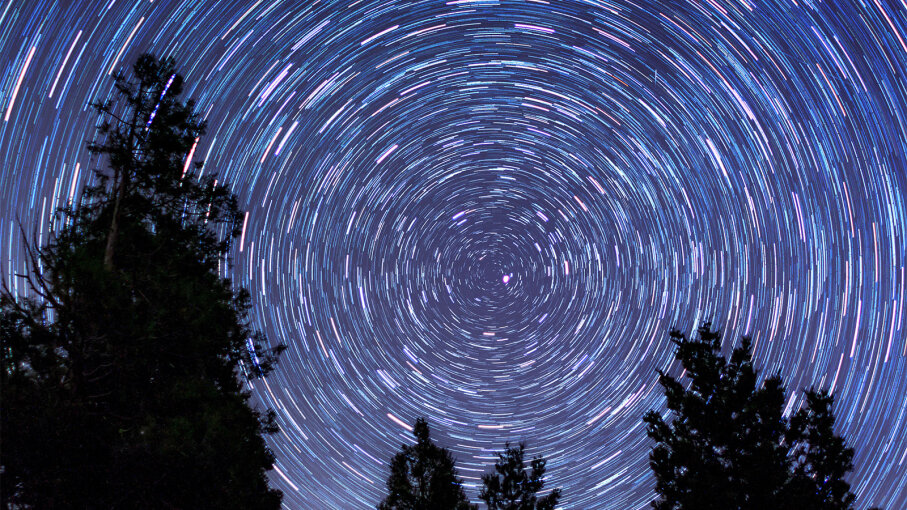 ...............................................................................................................................................................
...............................................................................................................................................................
Polaris The North Star
Why Is
the North Star So Stellarly Important?
BY PATRICK J. KIGER
If you ever
looked at the night sky in the Northern Hemisphere, you've noticed that
gleaming object that the rest of the heavens appears to move around.
What you're
seeing is Polaris, also known
as the North Star, which is approximately 430 light years away from Earth and
is part of the constellation Ursa Minor.
The North Star
is called that because its location in the night sky is almost directly over
the North Pole, according to Rick Fienberg, a Harvard-trained astronomer who now is press
officer of the American Astronomical
Society.
Polaris Doesn't Rise
and It Doesn't Set
"So, if you were to stand at the North Pole — latitude 90
degrees north — at night and look straight up, you'd see Polaris directly
overhead," Fienberg says via email.
"From other latitudes in the Northern Hemisphere, if you
face due north at night and look the same angle above the horizon as your
latitude (for example, look about halfway up – 45 degrees – if you live in
Portland, Oregon, at latitude 45 degrees north), you'll see Polaris shining
there."
Polaris is
attention-getting, because unlike all the other stars in the sky, Polaris is in
the same location every night from dusk to dawn, neither rising nor setting,
according to Fienberg.
Its looming
presence leads some people to think of it, mistakenly, as the brightest star in
the sky (it's actually the 48th brightest).
Even so, it's
about 2,500 times as luminous as our sun, because it's a massive supergiant
with a diameter nearly 40 times larger than the sun and five times the mass.
But Polaris
also happens to be far away for a star that's visible with the naked eye, which
reduces its brightness.
Who First Found the North Star?
Who discovered
the North Star? That's a complicated question.
Ancient
Egyptian astronomers in the Old Kingdom, between 4,700 and 4,100 years ago, had
a North Star, which they symbolically represented with a female hippopotamus,
according to Giulio Magli's book "Architecture, Astronomy
and Sacred Landscape in Ancient Egypt." But it wasn't
Polaris.
That's because
what humans perceive as the North Star changed over time.
"If you picture a line connecting Earth's North and South
Poles as the axis around which Earth rotates, that axis is slowly moving in its
own circle," explains Christopher Palma, a former
teaching professor in astronomy who currently is associate dean of the Eberly
College of Science at Penn State University, in an email.
"Often, this is compared to what happens when a top or a
spinning coin start to 'wobble' before falling over on their side. We say that
Earth's North Pole is 'precessing,' that is,
the line that goes from the North Pole to the South Pole traces out a circle
with a period of 26,000 years."
As a result, "over very long time periods (more than a
few thousand years), the North Pole moves with respect to the stars,"
Palma continues.
"So thousands of years ago, people on Earth saw the
star Thuban in [the
constellation] Draco appear due north, instead of Polaris."
The North Star in Navigation
Polaris seems
to have been first charted by the astronomer Claudius Ptolemy, who lived
from about 85 to 165 B.C.E. The star's location close to the celestial North
Pole eventually became useful to navigators.
"At night, in the Northern Hemisphere, if you can see
Polaris you can always tell which way is north (and, by extension, which ways
are south, east and west)," Fienberg says.
"It's true now, it's been true for hundreds of years
(including during the Age of Exploration in the
15th through 17th centuries), and it'll be true for hundreds more years. You
can also tell your latitude, since the angle from the horizon to Polaris is the
same as your latitude (to within a degree, anyway). Once you travel south of
the equator, though, Polaris drops below the horizon, so it's no longer useful
as a navigation aid."
Additionally,
a navigator using Polaris has to take into account that the star isn't
precisely over the North Pole but instead has an offset of 39 arc-minutes,
explains Rich Schuler, a lab
manager and adjunct faculty member who teaches astronomy at the University of
St. Thomas in St. Paul, Minnesota, in an email interview.
(He's author
of this 2002 primer on the
North Star in Scientific American.) That corresponds to an error of 44.7 miles
(72 kilometers), he says.
Here's Why the North Star Twinkles
One of the
other things that's intriguing about Polaris is that it's what astronomers
refer to as a Cepheid Variable star.
"This
star pulsates because it is in a state that is unstable," says Palma.
"It will swell up, and when it does, an outer layer of the
star becomes transparent, which then makes the star cool off. As a result of it
cooling off, it will shrink until it becomes opaque again, which causes it to
heat up and swell again. It will do this over and over again, pulsating in and
out, which causes its brightness to fluctuate."
And although
you can't tell when you gaze at Polaris in the night sky, it's actually part of
a triple star system.
"The two fainter stars (Polaris Ab and B) do not vary in
brightness because they are on the 'main sequence,' or are generating energy by
fusing hydrogen nuclei into helium nuclei only in the core of the star," Schuler
explains.
Polaris won't be the North Star forever. "If you look at
the 14,000 C.E. point, you'll see a star that's much, much brighter than
Polaris but farther from the circle," Fienberg says. "That's Vega, which our
descendants some 12,000 years from now (if humans are still around) will
consider their North Star."
NOW THAT'S INTERESTING
As Fienberg explains, "It's just a coincidence that at
this point in Earth's history the north-facing end of the axis happens to point
almost directly at a bright naked-eye star. The same is not currently true for
the south-facing end of the axis – in other words, there is no South
Star."
Patrick
J. Kiger
has written for HowStuffWorks since 2008 covering a wide array of topics, from
history and politics to pop culture and technology. He worked as a newspaper
reporter for the Pittsburgh Press, and the Orange County Register in
California, where he covered one of the biggest serial murder cases in U.S.
history, and also as a staff writer at Baltimore Magazine. As a freelancer,
Patrick has written for print publications such as GQ, Mother Jones and the Los
Angeles Times, and on the web for National Geographic Channel, Discovery News,
Science Channel and Fast Company, among others. In recent years, he's become
increasingly interested in how technological advances are altering urban life
and the design of cities, and has written extensively on that subject for Urban
Land magazine. In his spare time, Patrick is a longtime martial arts student
and a fan of crime fiction, punk rock and classic Hollywood films.
 |
A typical Northern Hemisphere star trail with
Polaris in the center.
|




:max_bytes(150000):strip_icc():format(webp)/GettyImages-548029033-58d6c48c3df78c5162f87517.jpg)